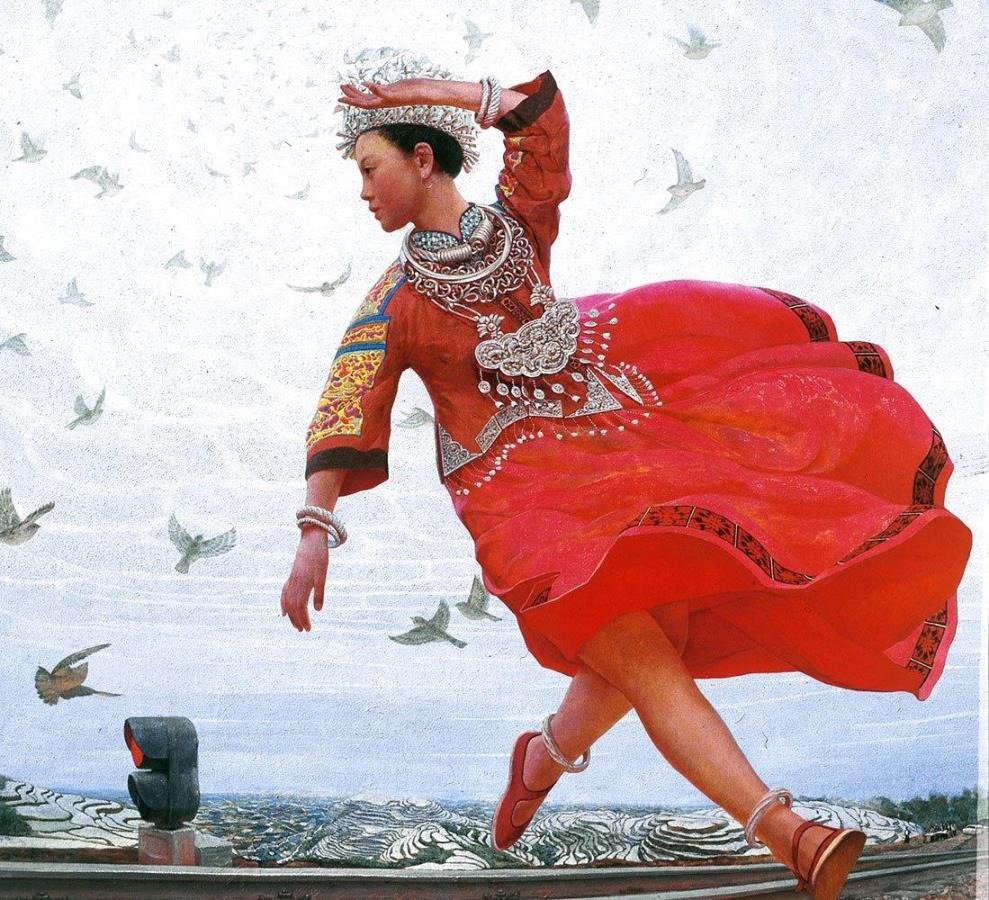Wang Yiguang's Paintings
Contemporary fine art is not without manifestations of beauty, even if they are not always visible to the general audience. And the more intriguing it is to look for and discover a wide range of riches inside it. Chinese artist Wang YiGuang produced the paintings). They show Tibet, females, and yaks. Wang Yiguang has always had a passion for art. He was influenced by his older brother Wang Yidong, who was also a well-known artist. Young Wang Yiguang, wanting to follow in his footsteps, enrolls at Beijing's Central Academy of Fine Arts. He learns a lot there and becomes a good painter, even gaining popularity by participating in art shows in China and other countries. His works have been shown in Tokyo, Hong Kong, Guangzhou, and, of course, Beijing.
Wang Yiguang was seeking for a steady job and gets one as a creative designer at a huge railway firm. He is dispatched to Tibet, and there, unexpectedly, Wang Yiguang discovers an incredible reservoir of inspiration. The Tibetan mountains figure in his works, and it is not just the mountains that leave an imprint on the painter from the people who live there. He witnessed a stark difference between the strained psyche of people living in major cities and the way life is here. Tibet's people were known for their happiness and lightness, as well as their deep regard for nature. There was something beautiful and spiritual about this, because they even treated animals differently than in major towns. Animals were given their own particular space in the world where they were not disadvantaged in any way. And the interpersonal relationships were pleasant and optimistic; there was no hatred in them, and there was room for everyone. And what was particularly intriguing was that this planet existed in severe natural conditions, where you had to work hard, and where not every city inhabitant could adjust to the unique, high-mountain environment.
Wang Yiguang has returned to the Tibetan Plateau numerous times since then. He was unaccustomed to having altitude sickness the first time he struggled in the highlands. This condition is related with a shortage of oxygen and reduced air pressure in comparison to the human environment. Wang Yiguang struggled for several days to adjust to the unfamiliar surroundings. According to his memories, he was laying on the grass, attempting to breathe, when local Tibetan girls ran by him, chasing yaks. The artist was amazed and charmed by the sight of youthful beauties galloping alongside massive, strong yaks. This is how the narrative got into his paintings. Wang Yiguang's paintings carry philosophical undertones. They appear to depict a fleeting movement, one of the moments of existence amid quite severe environmental surroundings. And this frozen moment takes the form of a magnificent flight, with humans and yaks flying through the air as if in zero gravity. The artist gave this a lot of attention, and these buried ideas can be sensed while looking at the paintings.
Wang Yiguang's work also has mythical elements. Thus, at Dunhuang, an ancient cave painting has been preserved, which includes pictures of flying goddesses among various worship imagery. The painter created a comparison between Tibetan females and the characters shown on the walls by drawing them. Paintings devoted to the people of the Tibetan Plateau frequently connect to native Tibetan mythology, in which the yak plays an important role. It has long been known as the ship of the highlands, and it is considered that the bond between man and yak is mystical. There is an ancient belief that if a young girl (who must be a virgin) raises a yak on her own, continuously being near to it and caring for it, the yak would disclose the mysteries of the cosmos to her when she reaches the age of eighteen. If their bond is strong enough, they will even teach them how to fly.
当代美术并非没有美的表现,即使它们并不总是为普通观众所见。 而越是寻找和发现其中蕴藏的丰富财富,就越令人着迷。 中国艺术家王贻光创作了这些画作)。 它们展示了西藏、女性和牦牛。
王轶光一直对艺术充满热情。 他受到了他的哥哥王亦东的影响,王亦东也是一位著名的艺术家。 年轻的王轶光想要追随他的脚步,考入了北京中央美术学院。 他在那里学到了很多东西,成为了一名优秀的画家,甚至通过参加中国和其他国家的艺术展而受到欢迎。 他的作品曾在东京、香港、广州,当然还有北京展出。
王贻光正在寻找一份稳定的工作,并在一家大型铁路公司找到了一份创意设计师的职位。 他被派往西藏,在那里,王贻光意外地发现了不可思议的灵感宝库。 西藏的山脉出现在他的作品中,给画家留下印记的不仅仅是山脉,还有居住在那里的人们。 他目睹了生活在大城市的人们紧张的心理和这里的生活方式之间的巨大差异。 西藏人民以快乐、轻松以及对自然的深切尊重而闻名。
这里有一些美丽和精神的东西,因为他们对待动物的方式甚至与大城市不同。 动物在世界上被赋予了自己独特的空间,在那里它们不会以任何方式处于不利地位。 人际关系愉快、乐观; 他们没有仇恨,每个人都有空间。 尤其耐人寻味的是,这个星球的自然条件十分恶劣,必须努力工作,而且并不是每个城市居民都能适应独特的高山环境。
此后,王亿光多次回到青藏高原。 第一次在高原上挣扎时,他还不太习惯,就出现了高原反应。 这种情况与人类环境相比缺氧和气压降低有关。 王一光花了好几天的时间才适应了陌生的环境。 据他回忆,当时他躺在草地上,试图呼吸,当地藏族女孩追着牦牛从他身边跑过。 年轻的美女与巨大而强壮的牦牛一起驰骋的景象让艺术家感到惊讶和着迷。 这就是叙事进入他的画作的方式。
王轶光的画作带有哲理色彩。 它们似乎描绘了一种转瞬即逝的运动,这是在相当恶劣的环境中存在的时刻之一。 这个凝固的瞬间以一场壮丽的飞行的形式呈现,人类和牦牛在空中飞翔,仿佛在零重力下。 艺术家对此给予了很多关注,这些隐藏的想法在观看绘画时可以感受到。
王轶光的作品也带有神话元素。 因此,在敦煌,保存了一幅古老的洞穴壁画,其中包括各种崇拜图像中的飞行女神图。 画家通过绘画将藏族女性与墙上的人物进行了比较。
描绘青藏高原人民的绘画经常与西藏本土神话联系在一起,而牦牛在其中扮演着重要的角色。 它自古以来就被誉为高原之舟,人们认为人与牦牛之间的联系是神秘的。 有一种古老的信仰,如果一个年轻的女孩(必须是处女)独自饲养一头牦牛,不断靠近它并照顾它,当她到了这个年龄时,牦牛就会向她揭示宇宙的奥秘。 十八岁。 如果他们的联系足够牢固,他们甚至会教他们如何飞行。


.JPG)
.JPG)
.JPG)
.JPG)
.JPG)
.JPG)
.JPG)
.JPG)
.JPG)
.JPG)
.JPG)
.JPG)
.JPG)
.JPG)
.JPG)
.JPG)
.JPG)
.JPG)
.JPG)
.JPG)
.JPG)
.JPG)
.JPG)
.JPG)
.JPG)
.JPG)
.JPG)
.JPG)
.JPG)
.JPG)
.JPG)
.JPG)
.JPG)
.JPG)
.JPG)



No comments:
Post a Comment